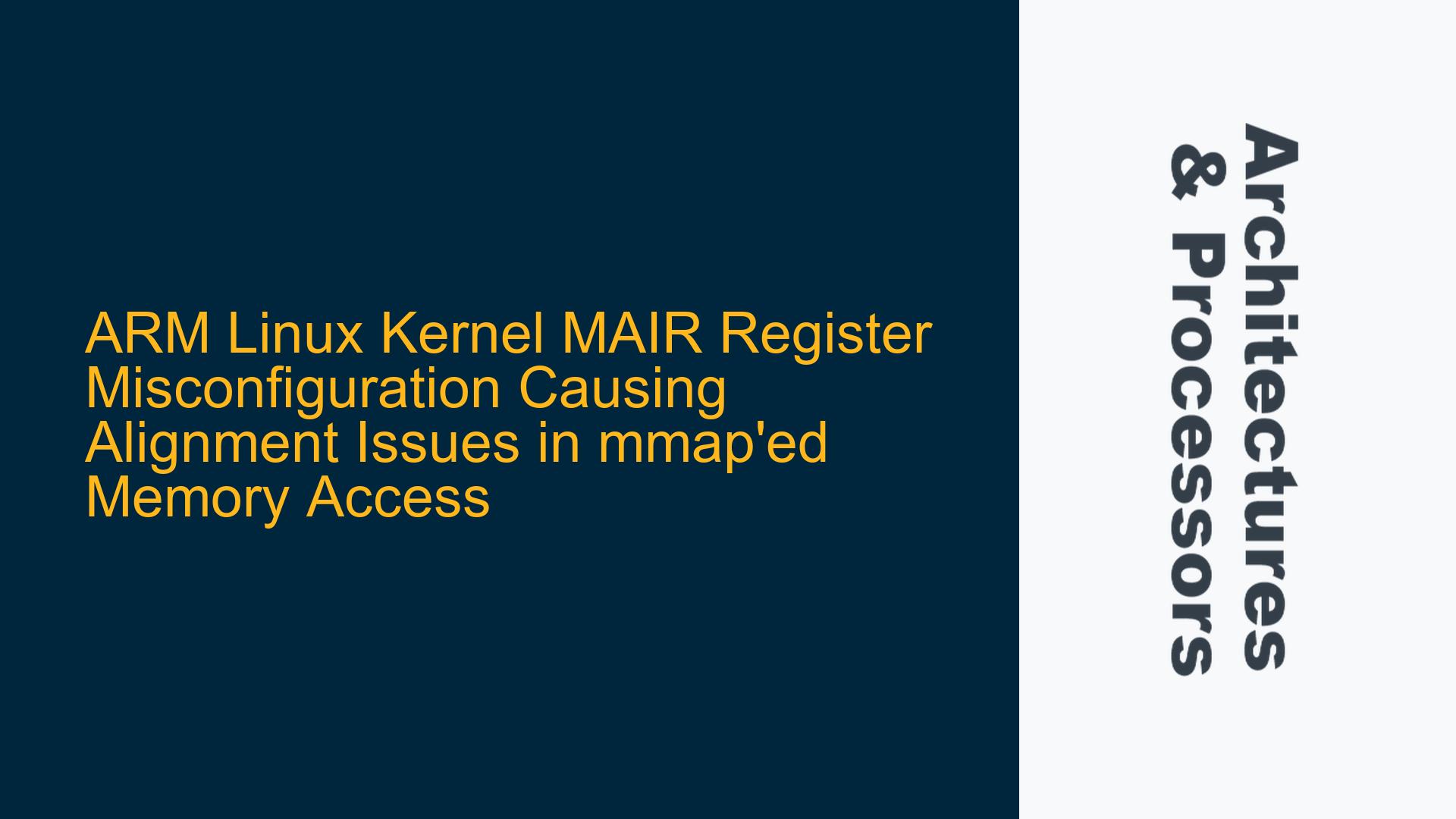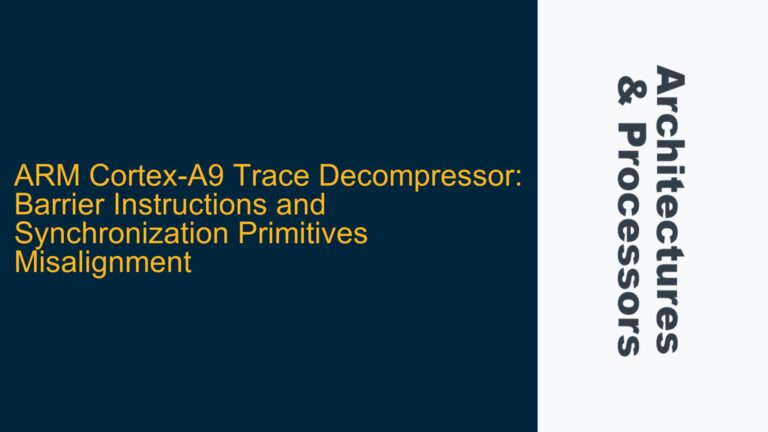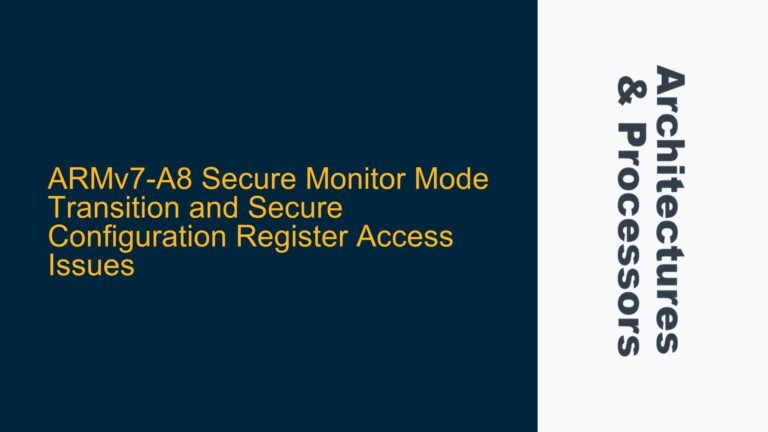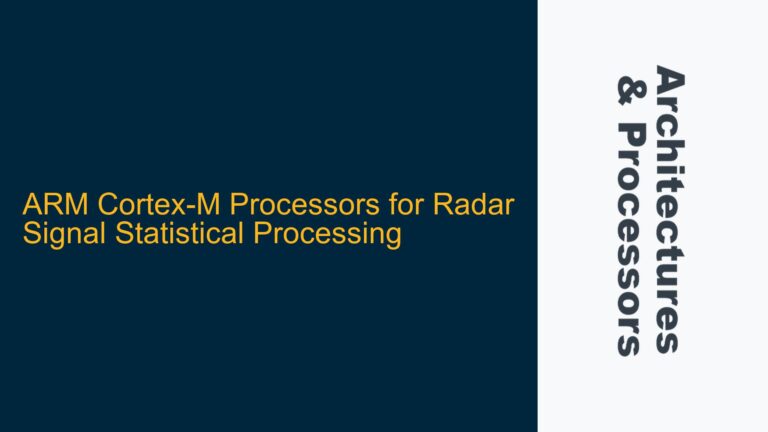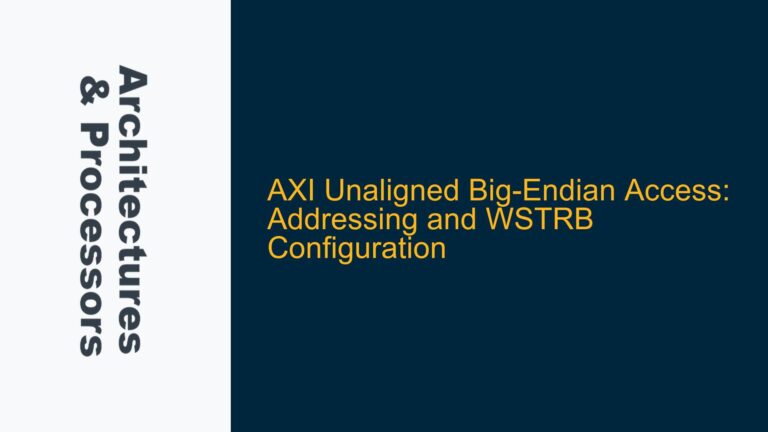ARM Cortex-A Memory Attribute Indirection Register (MAIR) Misconfiguration in Linux Kernel 5.10+
The issue revolves around a misconfiguration in the Memory Attribute Indirection Register (MAIR) in ARM Cortex-A processors when using Linux kernel versions 5.10 and above. This misconfiguration manifests as alignment issues during memory access operations such as memset() and memcpy() on mmap’ed memory regions. Specifically, the problem occurs when accessing byte 3 of a memory buffer, resulting in a bus error, while accesses to bytes 0, 1, and 2 succeed. This behavior is observed only in newer kernels (5.10 and 5.15), while the same code works flawlessly on kernel 5.4.
The root cause lies in the kernel’s handling of the MAIR register, which is responsible for defining memory attributes such as cacheability, shareability, and memory type (e.g., Normal, Device). In newer kernels, the contents of the MAIR register have been reorganized, leading to incorrect memory attribute assignments when using hardcoded MAIR indices. This misassignment causes the memory region to be treated as non-Normal memory, resulting in alignment faults during access.
The MAIR register is a critical component of the ARMv8-A memory management system. It allows the operating system to define up to eight memory attribute configurations, each referenced by an index in the page table entries. When the kernel or user-space applications access memory, the Memory Management Unit (MMU) uses these attributes to determine how the access should be handled. If the MAIR configuration is incorrect, the MMU may enforce stricter alignment requirements or disallow certain types of access altogether, leading to bus errors or alignment faults.
In this case, the misconfigured MAIR index caused the memory region to be treated as Device memory instead of Normal memory. Device memory has stricter alignment requirements and does not support unaligned accesses, which explains why the memset() and memcpy() operations failed when accessing byte 3. Normal memory, on the other hand, typically supports unaligned accesses, allowing the same code to work correctly on kernel 5.4.
Hardcoded MAIR Index and Kernel MAIR Reorganization
The primary cause of the issue is the use of a hardcoded MAIR index in the page table configuration. In older kernels (e.g., 5.4), the MAIR register’s contents were organized in a specific way, and the hardcoded index happened to point to the correct memory attributes for Normal memory. However, in newer kernels (5.10 and 5.15), the MAIR register’s contents were reorganized, causing the hardcoded index to reference incorrect memory attributes.
The MAIR register is typically initialized during kernel boot, and its contents are determined by the kernel’s memory management code. The reorganization of the MAIR register in newer kernels was likely done to optimize memory attribute assignments or to accommodate new features. This change, while beneficial in the general case, broke code that relied on hardcoded MAIR indices.
Another contributing factor is the lack of runtime checks for memory attribute consistency. When the kernel sets up the page tables for a memory region, it does not verify that the specified MAIR index corresponds to the intended memory attributes. This lack of validation allows incorrect configurations to go unnoticed until they cause runtime errors.
The issue is further compounded by the fact that the misconfigured memory region was marked as reserved in the kernel. Reserved memory regions are typically used for special purposes, such as shared buffers between the kernel and user space. These regions often require specific memory attributes to function correctly, making them particularly sensitive to MAIR misconfigurations.
Correcting MAIR Configuration and Ensuring Proper Memory Attribute Assignment
To resolve the issue, the hardcoded MAIR index must be replaced with the correct index for Normal memory. This can be achieved by querying the kernel for the current MAIR configuration and using the appropriate index. The following steps outline the process:
-
Identify the Correct MAIR Index for Normal Memory:
The first step is to determine the correct MAIR index for Normal memory in the current kernel version. This can be done by examining the kernel’s memory management code or by using kernel debugging tools to inspect the MAIR register’s contents. -
Update the Page Table Configuration:
Once the correct MAIR index has been identified, update the page table configuration to use this index. This may involve modifying the kernel code that sets up the page tables for the reserved memory region. -
Validate Memory Attribute Assignment:
After updating the MAIR index, validate that the memory region is correctly configured as Normal memory. This can be done by inspecting the page table entries and verifying that the correct memory attributes are applied. -
Test with
memset()andmemcpy():
Finally, test the updated configuration by performingmemset()andmemcpy()operations on the memory region. Ensure that all byte accesses succeed and that no alignment faults occur.
In addition to these steps, it is recommended to avoid hardcoding MAIR indices in future code. Instead, use kernel APIs or macros to obtain the correct indices dynamically. This approach ensures compatibility across different kernel versions and reduces the risk of similar issues arising in the future.
By addressing the MAIR misconfiguration and ensuring proper memory attribute assignment, the alignment issues can be resolved, allowing the mmap’ed memory region to function correctly on newer Linux kernels.
Detailed Explanation of MAIR Register and Its Role in Memory Management
The Memory Attribute Indirection Register (MAIR) is a key component of the ARMv8-A architecture’s memory management system. It allows the operating system to define up to eight memory attribute configurations, each referenced by an index in the page table entries. These configurations determine how the Memory Management Unit (MMU) handles memory accesses, including cacheability, shareability, and memory type.
The MAIR register is divided into eight 8-bit fields, each corresponding to a memory attribute configuration. Each field defines the attributes for a specific type of memory, such as Normal, Device, or Non-cacheable. The page table entries reference these configurations using a 3-bit index, allowing the MMU to apply the appropriate attributes to each memory region.
In the context of the issue, the MAIR register’s reorganization in newer kernels caused the hardcoded index to reference incorrect memory attributes. This misconfiguration led to the memory region being treated as Device memory, which has stricter alignment requirements and does not support unaligned accesses.
Impact of Memory Attribute Misconfiguration on System Performance
Misconfiguring the MAIR register can have significant implications for system performance and reliability. When a memory region is incorrectly marked as Device memory, the MMU enforces stricter alignment requirements and disables certain optimizations, such as write combining and speculative reads. This can lead to increased latency and reduced throughput for memory accesses.
In addition, misconfigured memory attributes can cause subtle bugs that are difficult to diagnose. For example, unaligned accesses that work correctly on Normal memory may fail on Device memory, leading to bus errors or alignment faults. These issues can be particularly challenging to debug, as they may only manifest under specific conditions or on certain kernel versions.
Best Practices for Managing MAIR Configuration
To avoid issues related to MAIR misconfiguration, follow these best practices:
-
Avoid Hardcoding MAIR Indices:
Hardcoding MAIR indices can lead to compatibility issues across different kernel versions. Instead, use kernel APIs or macros to obtain the correct indices dynamically. -
Validate Memory Attribute Assignment:
When setting up page tables for a memory region, validate that the specified MAIR index corresponds to the intended memory attributes. This can be done by inspecting the page table entries and verifying the applied attributes. -
Use Reserved Memory Regions Carefully:
Reserved memory regions often require specific memory attributes to function correctly. Ensure that these regions are configured with the appropriate attributes and that any changes to the MAIR register do not affect their functionality. -
Test Across Different Kernel Versions:
Test your code on multiple kernel versions to ensure compatibility and identify any issues related to MAIR reorganization or other changes in memory management.
By following these best practices, you can minimize the risk of MAIR-related issues and ensure that your code works correctly across different kernel versions and hardware platforms.
Conclusion
The alignment issue observed during memset() and memcpy() operations on mmap’ed memory regions in Linux kernels 5.10 and above is caused by a misconfiguration in the MAIR register. This misconfiguration results from the use of a hardcoded MAIR index that no longer points to the correct memory attributes due to the reorganization of the MAIR register in newer kernels.
To resolve the issue, the hardcoded MAIR index must be replaced with the correct index for Normal memory, and the page table configuration must be updated accordingly. Additionally, it is recommended to avoid hardcoding MAIR indices and to validate memory attribute assignments to prevent similar issues in the future.
By addressing the MAIR misconfiguration and ensuring proper memory attribute assignment, the alignment issues can be resolved, allowing the mmap’ed memory region to function correctly on newer Linux kernels. This approach not only fixes the immediate problem but also improves the robustness and compatibility of the code across different kernel versions and hardware platforms.
